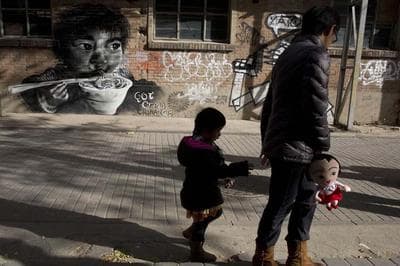Advertisement
China Chooses Change In Ten-Year Outlook
ResumeChina’s ten-year plan. Economic changes. Social changes. The planned new face of modern China.

Latest poll numbers show a third of Americans are optimistic about their economic outlook. In Spain, it’s four percent. In Greece it’s one percent. In China, 88 percent say they’re optimistic about the economic path ahead. This month, China’s leadership is laying out its big vision for the next ten years. The ten-year plan. Hard to imagine such a thing in the USA. China’s leaders say they’ll end the one-child policy. End labor camps for “re-education.” Further privilege market forces. But keep the central authority, the Communist Party, right in charge. This hour On Point: China’s ten-year plan.
-- Tom Ashbrook
Guests
Andrew Browne, China columnist for The Wall Street Journal. (@andybrownewsj)
Susan Shirk, chair of the 21st Century China Program and Ho Miu Lam Professor of China and Pacific Relations at the School of International Relations and Pacific Studies (IR/PS) at the University of California, San Diego. (@IRPS)
Damien Ma, fellow at the Paulson Institute. Author of "In Line Behind a Billion People: How Scarcity Will Define China's Ascent In the Next Decade." (@damienics)
From Tom's Reading List
Wall Street Journal: After Long Wind-Up, Xi Delivers Anticlimax — "The details were almost completely missing, even though the document ticked off many of the items that appear on standard lists of reform objectives for China, both inside and outside the country. These include pledges to overhaul the fiscal system, health care and education. The party has historically signaled policy changes in words and phrases that appear as riddles to outsiders, In that vein, the language of the communiqué does offer a few tantalizing, if murky, clues to deeper reform that may lie ahead."
NPR: China Sends 'Peace Ark' To Philippines Via Choppy Political Seas — "If you look at online polls, actually a lot of people were against giving aid to the Philippines. One of the things that they did was they cited this island dispute. They also - some people don't think it's really appropriate. Despite the incredible economic growth here, many Chinese are still relatively poor. And a lot of Chinese feel that the government should spend money on its own people and spend money at home."
BBC: No siblings: A side-effect of China's one-child policy — "The result - China's new singletons were more educated than generations before them. And Chinese education costs soared overnight. In the past, parents would usually choose just one of their children to progress in school. But after the one-child policy came into practice, each single child shouldered this focused pressure from two parents."
This program aired on November 26, 2013.